Balbharti Maharashtra State Board Class 10 Political Science Solutions Chapter 3 Political Parties Notes, Textbook Exercise Important Questions and Answers.
Maharashtra State Board Class 10 Political Science Solutions Chapter 3 Political Parties
Question 1.
Choose the correct option from the given options and complete the sentences.
(1) When people come together and participate in electoral process, to acquire political power, such organisations are called ………………………….. .
(a) Government
(b) Society
(c) Political parties
(d) Social organisations
Answer:
(c) Political parties
![]()
(2) National Conference is a party in ………………………….. this region.
(a) Odisha
(b) Assam
(c) Bihar
(d) Jammu and Kashmir
Answer:
(d) Jammu and Kashmir
(3) Justice Party- a non-Brahmin movement was transformed into ………………………….. Political Party.
(a) Assam Gan Parishad
(b) Shivsena
(c) Dravid Munnetra Kazhagam
(d) Jammu and Kashmir National Conference
Answer:
(c) Dravid Munnetra Kazhagam
Question 2.
State whether the following statements are true or false. Give reasons for your answer.
(1) Political parties act as a link between government and people.
Answer:
The above statement is True.
- The political parties convey the demands and complaints of the people to the government.
- Information about various government policies and schemes are conveyed to the people by the political parties.
- People’s reaction to the policies and their expectations are conveyed to the government too by the parties. In this way, political parties act as a link between government and the people.
(2) Political parties are social organisations.
Answer:
The above statement is True.
- People who have similar views come together voluntarily and form a party, so it can be said that political parties are an integral part of our society.
- The political parties try to solve the problems of the people.
- Some political parties represent the role of a particular community in society, its ideology and work to achieve it. Hence it can be said that political parties are social organizations.
![]()
(3) Coalition politics leads to instability.
Answer:
The above statement is False.
- As no single party got majority after the elections held in 1989, coalition government came to power at the centre and many states.
- Parties had to set aside their policies and programmes and concentrate on a common agenda to run the government.
- Both Congress Party and the Bharatiya Janata Party made an experiment of establishing a coalition government.
- The National Democratic Alliance formed by BJP and its partners and the Democratic Front government formed by Congress and its partners ruled at the centre and state level effectively.
Therefore, the belief that the coalition government brings instability was proved wrong.
(4) Shiromani Akali Dal is a national party.
Answer:
The above statement is False.
The Election Commission of India recognises a political party as National or Regional party on the basis of specific criteria namely:
- The number of seats secured in Parliament and Legislative Assembly or percentage of votes secured.
- Shiromani Akali Dal does not meet the criteria listed above.
- As its influence is limited to the state of Punjab and not in any other state.
- The Election Commission has given recognition to it as regional party.
Question 3.
Explain the following concepts.
(1) Regionalism
Answer:
- India is a vast country with great physical diversity. People belonging to different regions have their own language, culture and traditions.
- Along with the physical diversity, we find diversity in literature, education, history and movements.
- Each one feels an affinity for his language, traditions and history of social reforms. This gives rise to linguistic identity.
- This affinity towards all the above-mentioned aspects develops into identity consciousness and gives rise to excessive regional pride.
- People start giving preference only to the development of their language and region.
- This is known as Regionalism.
![]()
(2) National Parties
Answer:
A party which functions at the national level is known as National Party.
- The Election Commission has laid certain criteria for a party to get recognised as a Political party. The political party should secure at least f 6% valid votes in four or more states in the earlier Lok Sabha. OR
- State Assembly elections and minimum four members should be elected in the Lok Sabha from any state or states in the earlier elections. OR
- The candidates of a party should be elected from a minimum three states or should be elected from a minimum 2% constituencies of the total Lok Sabha constituencies. OR
- It is important to get recognition as a state party in at least four states.
Question 4.
Answer the following questions in brief.
(1) What are the major characteristics of political parties?
Answer:
The main features of political parties are as follows:
- Political parties aim at securing power by contesting elections.
- Every political party has some ideology.
- Every party has an agenda. It is based on the party’s ideology.
- The party that gets majority seats in election forms the government and the one that does not secure the majority act as opposition parties.
- Political parties are a link between the people and the government and work to gain the support of the people.
(2) What changes have taken place in the nature of political parties in India?
Answer:
The following changes were seen in the party system in India:
- Indian- National Congress was the only dominant party in states and at the centre after independence.
- All other parties came together and formed a coalition in 1977 and defeated the Congress.
- For the first time in history, the two-party system got importance over one-party system.
- The one-party system came to an end after the 1989 elections.
- Regional parties got importance and the coalition government was formed at the centre and in the states.
Project
(1) In a map of Maharashtra, point out the Loksabha constituency that includes the names of your parents.
(2) In a map of India, point out the places where national political parties have their influence.
Answer:
Memory Map
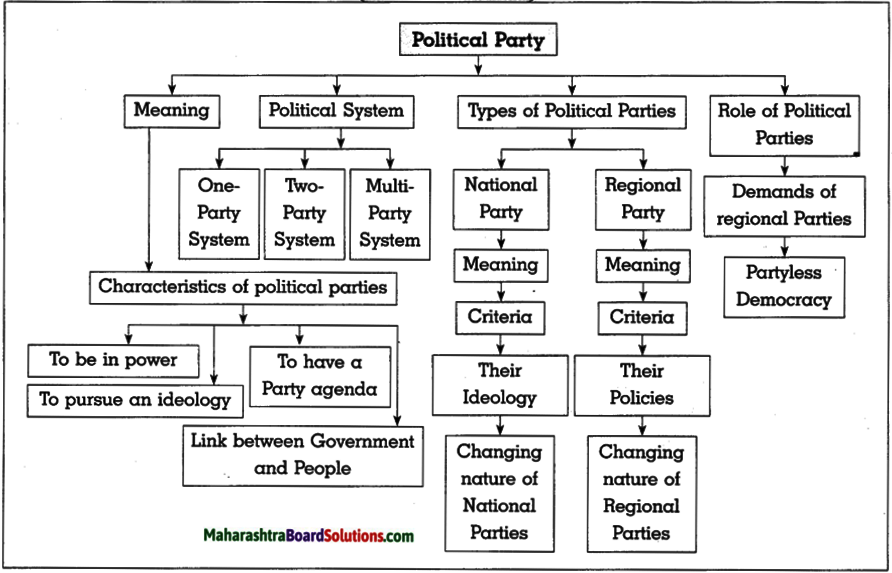
![]()
Question 5.
Choose the correct option from the given options and complete the sentences:
(a) The party which fails to secure majority is known as ………………………. party.
(a) Ruling
(b) Opposition
(c) Independent
(c) Coalition
Answer:
(b) Opposition
(b) ‘Bharatiya Janata Party’ which was formed in 1980 after a split with ………………………. a component of Janata Party.
(a) Jan Sangh
(b) Lok Dal
(c) Independent party
(b) Janata Dal
Answer:
(a) Jan Sangh.
(c) Social support received by a political party is called ………………………. .
(a) Democracy
(b) People’s rule
(c) Mass base
(d) Public relation
Answer:
(c) Mass base
(d) Promotion of the Marathi language is the objective of the ………………………. .
(a) Dravida Munnetra Kazhagam
(b) Shiromani Akali Dal
(c) Shiv Sena
(d) Assam Gana Parishad
Answer:
(c) Shiv Sena
(e) There are ………………………. recognised parties in India.
(a) five
(b) seven
(c) nine
(d) six
Answer:
(b) seven
(f) The main objective of the political party is to capture ………………………. and retain it.
(a) publicity
(b) victory
(c) power
(d) information
Answer:
(c) power
![]()
(g) The ideology of the Communist Party of India is based on ………………………. Philosophy.
(a) Capitalist
(b) Marxist
(c) Democracy
(d) Imperialist
Answer:
(b) Marxist
(h) Shiromani Akali Dal is a prominent regional party in ………………………. state.
(a) Odisha
(b) Assam
(c) Punjab
(d) Jammu and Kashmir
Answer:
(c) Punjab
Question 6.
State whether the following statements are true or false. Give reasons for your answer:
(a) Political parties do not need support of the people.
Answer:
The above statement is False.
- To secure power is the main aim of political parties.
- Political parties have to implement various policies and programmes for the welfare of people and to gain the support of the people.
- The party which solves the issues related to the welfare of the people get support.
- Without the support of the people they can never get a mandate.
Hence, all political parties require support of the people.
(b) The Communist Party of India was split.
Answer:
The above statement is True.
- The Communist Party of- India was established in 1925. The Communist Parties follow Marxist ideology.
- In 1962, due to differences in the leadership a rift was created in the party.
- The main reason for the split was about which political line to follow.
(c) Sometimes the sentiments of regionalism gets strengthened in the country.
Answer:
The above statement is True.
- A country like India has diversity of government language, region and culture. This diversity creates affinity towards a region.
- This affinity gives rise to excessive regional S pride and initiating movements to save it. The significance of such movements is claimed to be for preserving culture.
- Asserting to be rightful claimant of material resources, job opportunities and development of the region these movements strengthen the regional pride.
- Thus, this excessive regional pride turns morbid taking the form of regionalism.
![]()
(d) Regional parties have no influence on National Politics.
Answer:
The above statement is False.
- No single party got majority in the elections to Lok Sabha held in 1989.
- The national parties formed coalition government at the centre taking help of regional parties.
- As regional parties share power at the centre they have influence on national politics.
Question 7.
Explain the concept:
(a) Regional Parties:
Answer:
- The groups having a proud feeling about the different identity of their region and who compete to capture power to bring about regional development are ‘Regional Parties’.
- The influence of such parties are limited to their region. They give importance to regional problems. Development of one’s own region is the prime objective of these parties.
- Sometimes they demand for independent state or autonomy. They influence the national politics because of their dominance in the region.
- They have passed through various phases, from separatism to autonomy and have then merged with mainstream national politics.
(b) Political Party:
Answer:
- A Political Party is a kind of social organisation of like-minded people. The main aim of any political party is to contest election and secure power.
- The stand taken by various political parties on issues becomes their political ideology.
- In democracy, political parties are at the centre of all political activities. They are a link that connects common people, democracy, representation and elections.
- The party that secures a majority becomes the ruling party and the rest are known as the. opposition.
Question 8.
Write short note:
(a) Party System:
Answer:
- If one party remains in power in a country for a long period and no other party has any kind of influence the party system it is called ‘One- Party System’.
- When there are two equally strong parties which alternatively come to power. It is called ‘Two-Party System’.
- In a country where many political parties exist and compete with each other to capture power and have more or less influence in different states is called ‘Multi-Party System’.
- Democracy develops in Multi-Party System.
(b) Indian National Congress:
Answer:
- The Indian National Congress was established in 1885.
- The party represented the hopes and aspirations of Indians and led the freedom struggle.
- Groups having diverse ideologies became part of the Congress to fight for freedom.
- It believes in democratic socialism, social equality and international peace.
- After independence, the Congress Party was a dominant party for almost four decades and ruled at the centre and in the states.
![]()
(c) Communist Party of India:
Answer:
- The Communist Party of India was established in 1925. The Communist Party follows the Marxist ideology.
- The party aims at working to protect the interests of workers and labourers.
- The main objective of this party is to oppose capitalism and protect the interests of workers.
- The party split due to ideological differences in 1964. Those who walked out of the party formed Communist Party (Marxist).
(d) Nationalist Congress Party:
Answer:
- Nationalist Congress Party (NCP) is the splinter or breakaway party from the Congress Party.
- It considers the values like democracy, equality and secularism important.
- It became part of United Progressive Alliance (UPA) and came to power in Maharashtra.
- It was in power in Maharashtra from 1999 to 2014 and at the centre from 2004 to 2014.
(e) Trinamool Congress:
Answer:
- All India Trinamool Congress was established in 1998.
- The Election Commission of India gave it recognition in 2016.
- Democracy, Secularism and protection of the weaker sections of the society are some of the policies of the party.
- Presently (April 2019), this party is in power in the state of West Bengal.
(f) Shiv Sena:
Answer:
- The Shiv Sena was founded in 1966.
- The main objective of the party was to fight for the cause of Marathi-speaking people and preservation of Marathi language.
- They resisted the people from other regions.
- In 1995, it became the ruling party with BJP in Maharashtra and its strategic tie-up with BJP helped it to enter national politics.
- It was in power at the centre with BJP from 1998 to 2004. Again it has shared power with the BJP at the centre and state since 2014.
(g) Shiromani Akali Dal:
Answer:
- Shiromani Akali Dal was formed in 1920.
- It is a dominating party in Punjab.
- It gives preference to nurture religious and for the regional pride.
- The party has retained power in Punjab for many years.
(h) Dravid Munnetra Kazhagam:
Answer:
- Justice party, a non-Brahmin movement, started in 1920. In 1944, it transformed into a political party called Dravid Kazhagam.
- In 1949, a group within the party got split and formed Dravid Munnetra Kazhagam (DMK).
- The party works for the protection of Tamil identity.
- This party implemented many policies for welfare of the people and therefore has support from all the sections of society.
- Another group separated from it in 1972 and formed All India Dravid Munnetra Kazhagham.
- It remained in power for a long time in Tamil Nadu and for sometime at the centre.
![]()
Question 9.
Do as directed
(a) Complete the concept map:
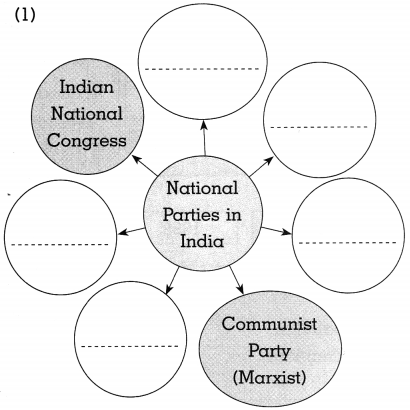
Answer:
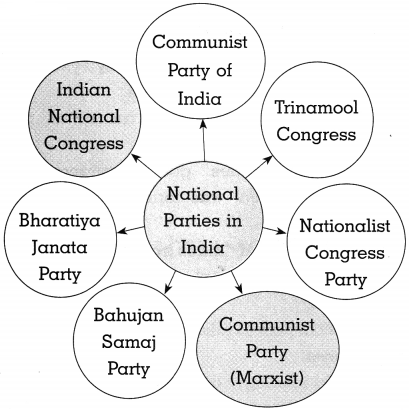
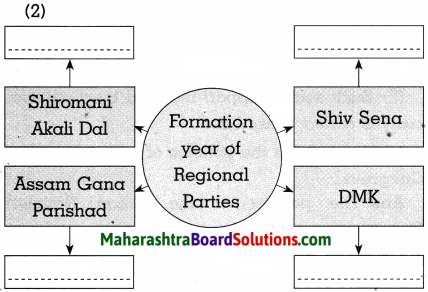
Answer:
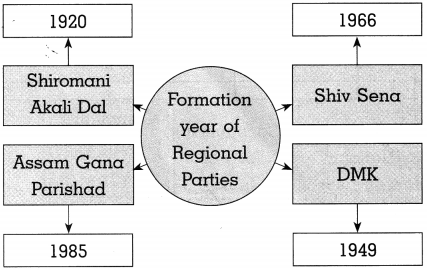
![]()
(3)
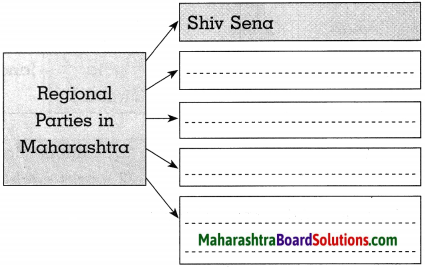
Answer:
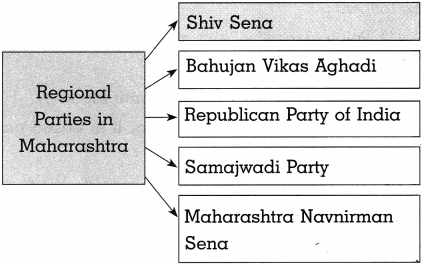
(b) Complete the Time-line writing the name of the party or the year of establishment:

Answer:

Question 10.
Answer the following questions in brief:
(a) What is called “mass base”?
Answer:
- Every political party is formed with some ideology.
- Political parties take a certain stand towards public issues.
- Their ideology and their stand towards public issues are conveyed to the people through various programmes.
- If the people agree with their role and ideology, they get the support of the people.
- Such social support received by a political – party is called ‘mass base’.
(b) Write about the policies of Indian National Congress.
Answer:
The policies of the Indian National: Congress are as follows:
- Equal rights for the minorities and weaker sections of society.
- Secularism, all-round development and social welfare are its objectives.
- Introduction of socialist democracy.
- Belief in values like international peace and social equality.
![]()
(c) Explain the role of Bharatiya Janata Party.
Answer:
Bharatiya Janata Party was formed in 1980 with the following objectives:
- To preserve Indian culture and traditions.
- To create a strong and rich India.
- To give importance to economic reforms for development of India.
(d) Write about the policies of Communist Party of India (Marxist).
Answer:
Communist Party of India (Marxist) was formed in 1964 with the following objectives:
- The party advocates socialism, secularism and democracy.
- The main policy of the party is to work for the welfare of farmers, landless labourers and workers.
- The party opposes imperialism.
(e) Why was Bahujan Samaj Party formed?
Answer:
The Bahujan Samaj Party was formed in 1984 to achieve the following objectives:
- To bring socialist ideology into practice.
- To secure power for ‘majority’ comprising of scheduled castes, scheduled tribes and other backward classes.
- To give power in the hands of ‘majority’.
(f) What do the regional parties give preference for?
Answer:
The regional parties give preference to the following issues:
- Importance should be given to regional issues and bring about development.
- Regional issues should be handled* at regional level.
- The power rests in the hands of regional people. ‘
- People living in that region should get preference in administration and jobs. .
(g) What changes are seen in the nature and role of regional parties?
Answer:
The role of regional parties changed over period of time. The changes are as follows:
- After independence, regional identity gave rise to separatists movements and demands were put up by regional parties for separate state.
- They wanted to break away from the Indian union and form a separate state.
- The demands of the regional parties changed gradually and these parties started asking for autonomy.
- In the later period, for the development of their region and people the parties demanded representation of their people in the state and central government.
- Regional parties in the north eastern region also started demanding more autonomy after split up.
- The journey of the regional parties began with a split up and then a demand for autonomy going on to share power in federation and then entry into mainstream national politics.
![]()
(h) What are the objectives of Assam Gana Parishad?
Answer:
Assam Gana Parishad was formed in 1985 with the following objectives:
- To preserve the uniqueness of Assam’s culture, language and social identity.
- To make efforts for economical development of Assam.
- To resolve problems of displaced people.
(i) What are the criteria for a regional party to get recognition?
Answer:
- In the last general .elections to the State Assembly, the party should not secure less than 6% of the total number of valid votes polled.
- At least 2 members to be elected to the Legislative Assembly (Vidhan Sabha).
- 3% seats of the total seats of Legislative Assembly or at least 3 seats in Legislative Assembly.
(j) What work is done by political parties?
Answer:
The following work is done by political parties:
- To propagate policies and programmes of the party and contest elections.
- They implement various policies when they come to power.
- If they fail to secure power, they act as opposition party and try to gain support of the people.
- They communicate the demands and complaints of the people to the government and the policies and programmes of the government to the people.
Question 11.
Give your opinion:
(a) Imagine you are opposition party leader and you have observed that the ruling party has not done good work in the field of health. What will you do as a leader of opposition?
Answer:
As opposition leader, I will do the following to make the government realise its negligence in the health field:
- I will question the government in Parliament and point out their shortcomings and ask about the prolonged projects.
- I will create awareness among the people by writing articles in newspapers.
- I will give interviews,on radio and television and criticize the government.
- I will organise rallies and meetings to sensitize among the people.
(b) Think and write
What has to be done to bring partyless democracy in modern times?
Answer:
- The recognition of all the parties should be cancelled. ‘
- People should be given the right to make decisions.
- In order to improve the decision-making power, people should be educated on political issues.
- To improve the moral character of the people who want to take the leadership.
- To initiate direct democracy and prepare the people for the same.
- Stress should be given for decentralization.
- Mahatma Gandhi, Vinoba Bhave and Jayprakash Narayan put forth the idea of partyless democracy.
- What has to be done to bring such democracy in modern times?
![]()
Question 12.
What do you understand by the following news in newspapers? Explain in brief.
(a) Opposition parties held a meeting in Mumbai to resist the Ruling party. Will take up the issue of farmers?
Answer:
- The ruling party did not undertake any work for the welfare of farmers. Therefore all the opposition parties decided to trap the government on this issue.
- The opposition parties have kept aside their differences and come together for this cause.
- It is the duty of the opposition party to question the negligence of the government.
- This news makes us aware of the line of action taken by the opposition.
- Opposition parties held a meeting in Mumbai to resist the Ruling party. Will take up the issue of farmers?
- Ruling party organised ‘Samvad Yatra’ in rural areas.
(b) Ruling party has organised ‘Samvad Yatra’ in rural areas.
Answer:
- Political parties adopt different ways to popularise their party and influence the people.
- As the means of communication are limited in rural areas they organise the Yatra.
- It shows the efforts of the government to understand problems of people in rural areas.
- It is essential to have dialogue with people to know their problems and opinions.
- As the initiative is taken by the government, people will develop faith in government.
- The news conveys to us that the ruling party is carrying out its duties properly.
- The faith in government becomes profound when people feel that government is sensitive towards them.